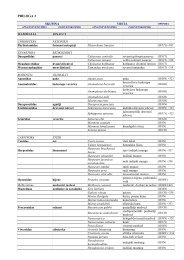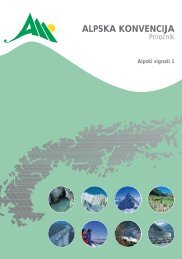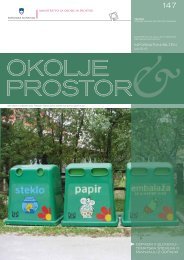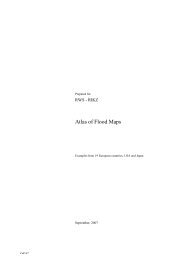The restoration of tributaries of Cerknica Lake and Škocjan Caves ...
The restoration of tributaries of Cerknica Lake and Škocjan Caves ...
The restoration of tributaries of Cerknica Lake and Škocjan Caves ...
You also want an ePaper? Increase the reach of your titles
YUMPU automatically turns print PDFs into web optimized ePapers that Google loves.
1. CERKNICA LAKE<br />
1.1. Basic characteristics<br />
<strong>The</strong> <strong>Lake</strong> <strong>Cerknica</strong> is an intermittent lake appearing at the bottom <strong>of</strong> Cerkniško polje. It is<br />
the largest Slovenian turloughs <strong>and</strong> also one <strong>of</strong> the most important sites in Europe. It has very<br />
special conditions <strong>of</strong> the area with big diversity <strong>of</strong> plants, animals <strong>and</strong> habitats. In the past,<br />
people wanted to transform the area for their benefit. In order to do that, people have made a<br />
lot <strong>of</strong> interventions in the watercourses <strong>and</strong> sinkholes <strong>of</strong> the lake. All these interventions<br />
caused big changes <strong>of</strong> the water regime <strong>of</strong> the lake.<br />
Intermittent lake <strong>of</strong> <strong>Cerknica</strong> is not the lake in the true sense <strong>of</strong> the word, but it is the bottom<br />
<strong>of</strong> the karst field, which is filled during the autumn rains <strong>and</strong> usually remain flooded until the<br />
end <strong>of</strong> spring. <strong>The</strong> lake is filled in 2 to 3 days <strong>and</strong> covers about 29 km 2 . <strong>Lake</strong> inflows are<br />
mostly karst waters which originate in the southern <strong>and</strong> eastern edge <strong>of</strong> <strong>Cerknica</strong> field.<br />
<strong>Lake</strong> <strong>Cerknica</strong> belongs to karst region <strong>of</strong> the Ljubljanica river basin. <strong>The</strong> karst catchment area<br />
<strong>of</strong> Ljubljanica River is besides <strong>of</strong> the Trieste karst classified as one <strong>of</strong> the classic karst areas<br />
<strong>of</strong> Europe. One <strong>of</strong> the most interesting phenomena in this area is definitely intermittent <strong>Lake</strong><br />
<strong>Cerknica</strong> <strong>and</strong> specific are also streams Pivka, Unica, Ljubljanica <strong>and</strong> many limestone caves.<br />
Figure 2. <strong>The</strong> <strong>Cerknica</strong> lake (Photo: Rok Fazarinc).<br />
Hydrological area <strong>of</strong> <strong>Cerknica</strong> Karst Polje with <strong>tributaries</strong> measures 242 km 2 <strong>and</strong> two<br />
catchment areas <strong>of</strong> the <strong>Cerknica</strong> <strong>Lake</strong>, Loka <strong>and</strong> Bloke area, measures 185 km 2 <strong>and</strong> 47 km 2 .<br />
All together the catchment area <strong>of</strong> <strong>Lake</strong> <strong>Cerknica</strong> with <strong>tributaries</strong> covers about 474 km 2 ,<br />
which is almost 43% <strong>of</strong> total Ljubljanica river basin before it flows into Sava River.<br />
In addition to the inflow from the karst catchment area Loka field <strong>and</strong> Bloke plateau,<br />
<strong>Cerknica</strong> field has also water inflow <strong>of</strong> significant quantities <strong>of</strong> the surface or subsurface<br />
waters. From eastern <strong>and</strong> northern edge comes the water supplies from streams Lipsenjščica,<br />
Žirovniščica, Martinski potok, Grahovščica <strong>and</strong> Goriški Brežiček. On the western outskirts <strong>of</strong><br />
the field from under Javorniki flows the water through permanent or temporary springs<br />
Tresenc, Otoški Obrh, Mrzlek <strong>and</strong> through the Vranja cave <strong>and</strong> Suhodolnica. From the<br />
extreme north-east fringe comes the water supplies <strong>of</strong> the stream Cerkniščica the only one<br />
with appearance <strong>of</strong> non-Karst surface watercourse.<br />
In the first half <strong>of</strong> last century, the water management company made the reduction <strong>of</strong> sinks<br />
<strong>and</strong> some siphons, expansion <strong>and</strong> reduction <strong>of</strong> underground channels, regulation <strong>of</strong> the Stržen







